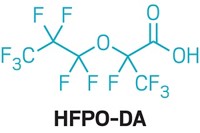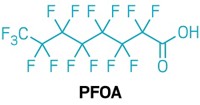Advertisement
Grab your lab coat. Let's get started
Welcome!
Welcome!
Create an account below to get 6 C&EN articles per month, receive newsletters and more - all free.
It seems this is your first time logging in online. Please enter the following information to continue.
As an ACS member you automatically get access to this site. All we need is few more details to create your reading experience.
Not you? Sign in with a different account.
Not you? Sign in with a different account.
ERROR 1
ERROR 1
ERROR 2
ERROR 2
ERROR 2
ERROR 2
ERROR 2
Password and Confirm password must match.
If you have an ACS member number, please enter it here so we can link this account to your membership. (optional)
ERROR 2
ACS values your privacy. By submitting your information, you are gaining access to C&EN and subscribing to our weekly newsletter. We use the information you provide to make your reading experience better, and we will never sell your data to third party members.
Pollution
GenX chemicals taint sediments
For the first time, researchers find fluoroethers in North Carolina riverbed
by Cheryl Hogue
April 5, 2018
| A version of this story appeared in
Volume 96, Issue 15

In a finding that has implications for drinking water safety, researchers at the University of North Carolina, Wilmington, have identified fluorochemicals linked to a Chemours plant in river sediment.
Previously, scientists found compounds related to Chemours’s GenX fluorosurfactant in the waters of the Cape Fear River downstream of the company’s plant near Fayetteville, N.C.
New results from state-funded investigations by UNC-Wilmington researchers mark the first time hexafluoropropylene oxide dimer acid (HFPO-DA)—the product of GenX hydrolysis—and related fluoroethers have been found in the river’s sediment.
“An initial conclusion from this study is that sediments are acting as a repository of GenX[-related compounds] that may be released into the overlying water column,” says a report on the studies sent to a state commission earlier this month. This means that sensitive ecosystems as well as drinking water utilities could continue to be affected by the pollution even if Chemours’s plant stops releasing fluoroethers into the environment.
To stem the source of the contamination, Chemours’s Fayetteville plant last year began capturing its fluorocarbon-related wastewater and shipping it to Texas for disposal. In February, state regulators required Chemours to control the facility’s air emissions of poly- and perfluorinated chemicals.
The discovery of fluoroethers in the sediment suggests Chemours could face cleanup liability if regulators decide the contaminated solids need to be removed from the Cape Fear River to protect public health or the environment. The toxicity of these compounds isn’t clear yet.
The UNC-Wilmington investigators used high-resolution mass spectrometry to find several fluoroethers in sediment that researchers previously identified in Cape Fear River water and in treated drinking water in Wilmington: HFPO-DA, five other perfluoroalkyl carboxylic acids, and one sulfonic acid byproduct of Chemours’s Nafion polymers.
The team also discovered two other substances not yet reported in published literature. The researchers are working to elucidate the chemical structures. These compounds appear to be perfluorinated and contain a single atom of chlorine, the report says.




Join the conversation
Contact the reporter
Submit a Letter to the Editor for publication
Engage with us on Twitter